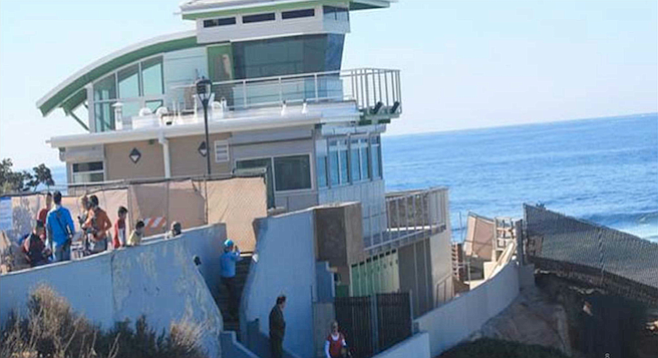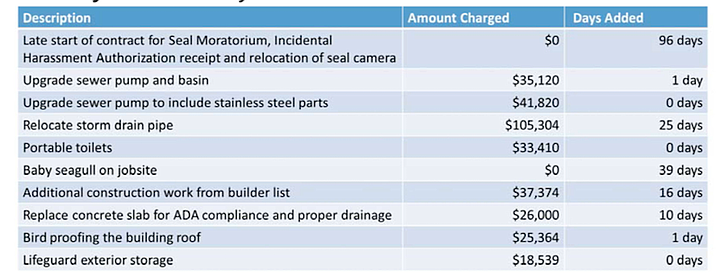 Facebook
Facebook
 X
X
 Instagram
Instagram
 TikTok
TikTok
 Youtube
Youtube

City officials are blaming seal pupping and a baby seagull for a portion of the months-long delay and a near million-dollar cost overrun that plagued construction of a posh new lifeguard station in the city's wealthiest community.
"Total estimated project cost as of January 27, 2017, was $4,324,773 which was an increase of 21 percent over the beginning project budget of $3,591,481," says a September 19 city audit report regarding the La Jolla Children's Pool Lifeguard Station. Contractor Stronghold Engineering, Inc. of Riverside required three years to complete the project.

"The original Stronghold Engineering, Inc. authorized contract amount was $2,707,127 with a project duration of 220 working days," says the audit, but that turned out to be overly optimistic.
"Over the life of the contract, change orders and contingency fund authorizations were used to charge over $575,000 and add 281 working days to the Stronghold Engineering contract."
One key problem, auditors say, was the failure of the city to anticipate delays caused by the nearby presence of a longstanding harbor seal colony, the disturbance and harassment of which is banned by federal law.
"The construction schedule was halted by three seal pupping moratoriums lasting from December 15th to June 1st in 2014, 2015, and 2016," says the audit.
In addition, per the document, "After the 2014 pupping moratorium ended in May 2014, construction was further delayed 39 working days by the presence of a baby seagull on the construction site....
"Environmental monitoring fees and temporary facilities also impacted the overall cost," the audit continues. "Monitoring and temporary facility rental costs were compounding due to a lengthened construction schedule."
Bird-proofing the roof tacked on $25,000, and an "above ground macerator pump was needed to accommodate the disposal of discarded public waste items. This system was redesigned during construction and later upgraded post‐construction when the system failed."
Besides the purported acts of nature, higher costs were introduced by requests from lifeguards to upgrade the new facility with features not previously included in the construction budget.
"Lifeguard requests/requirements that were not established prior to the commencement of construction had a substantial impact on the cost and completion date of the project," according to the document. "These requests/requirements also affected the Lifeguard Station design."
As a result, the audit says, "change orders were used to add 'contingency' amounts to the contract to offset additional contract cost which were approved by the City through a contingency fund authorization process. Seven change orders and 34 contingency fund authorizations were processed for the design‐build contract.
"These change orders were 21 percent of the original contract amount and exceeded the 10 percent threshold identified in the Institute of Internal Auditing 'Blueprint to Construction Auditing.'"
Compounding the project's woes, say auditors, "the building exterior is showing signs of rust. According to Public Works, Stronghold Engineering, Inc. has since cleaned and recoated the exterior steel in accordance with the manufacturer’s recommendations."
"Going forward, a strict maintenance protocol is needed to slow the impact of saltwater on the steel exterior components of the Lifeguard Station."
Concludes the report, "Public Works used a method of project delivery — design-build — that was not the traditional method for the City. In this type of project delivery, one entity provides engineering design and construction services.
"The Lifeguard Station and public restrooms [were] a challenging project that was built in an environmentally sensitive location which had to meet community expectations as well as lifeguard requirements.
"Some of these issues could have been identified earlier in the design process and reflected in the bid documents rather than identified later in the project. This would have given a better estimation of project cost for the [Request for Proposals] and may have reduced the total project cost if project duration could have been shortened."


City officials are blaming seal pupping and a baby seagull for a portion of the months-long delay and a near million-dollar cost overrun that plagued construction of a posh new lifeguard station in the city's wealthiest community.
"Total estimated project cost as of January 27, 2017, was $4,324,773 which was an increase of 21 percent over the beginning project budget of $3,591,481," says a September 19 city audit report regarding the La Jolla Children's Pool Lifeguard Station. Contractor Stronghold Engineering, Inc. of Riverside required three years to complete the project.

"The original Stronghold Engineering, Inc. authorized contract amount was $2,707,127 with a project duration of 220 working days," says the audit, but that turned out to be overly optimistic.
"Over the life of the contract, change orders and contingency fund authorizations were used to charge over $575,000 and add 281 working days to the Stronghold Engineering contract."
One key problem, auditors say, was the failure of the city to anticipate delays caused by the nearby presence of a longstanding harbor seal colony, the disturbance and harassment of which is banned by federal law.
"The construction schedule was halted by three seal pupping moratoriums lasting from December 15th to June 1st in 2014, 2015, and 2016," says the audit.
In addition, per the document, "After the 2014 pupping moratorium ended in May 2014, construction was further delayed 39 working days by the presence of a baby seagull on the construction site....
"Environmental monitoring fees and temporary facilities also impacted the overall cost," the audit continues. "Monitoring and temporary facility rental costs were compounding due to a lengthened construction schedule."
Bird-proofing the roof tacked on $25,000, and an "above ground macerator pump was needed to accommodate the disposal of discarded public waste items. This system was redesigned during construction and later upgraded post‐construction when the system failed."
Besides the purported acts of nature, higher costs were introduced by requests from lifeguards to upgrade the new facility with features not previously included in the construction budget.
"Lifeguard requests/requirements that were not established prior to the commencement of construction had a substantial impact on the cost and completion date of the project," according to the document. "These requests/requirements also affected the Lifeguard Station design."
As a result, the audit says, "change orders were used to add 'contingency' amounts to the contract to offset additional contract cost which were approved by the City through a contingency fund authorization process. Seven change orders and 34 contingency fund authorizations were processed for the design‐build contract.
"These change orders were 21 percent of the original contract amount and exceeded the 10 percent threshold identified in the Institute of Internal Auditing 'Blueprint to Construction Auditing.'"
Compounding the project's woes, say auditors, "the building exterior is showing signs of rust. According to Public Works, Stronghold Engineering, Inc. has since cleaned and recoated the exterior steel in accordance with the manufacturer’s recommendations."
"Going forward, a strict maintenance protocol is needed to slow the impact of saltwater on the steel exterior components of the Lifeguard Station."
Concludes the report, "Public Works used a method of project delivery — design-build — that was not the traditional method for the City. In this type of project delivery, one entity provides engineering design and construction services.
"The Lifeguard Station and public restrooms [were] a challenging project that was built in an environmentally sensitive location which had to meet community expectations as well as lifeguard requirements.
"Some of these issues could have been identified earlier in the design process and reflected in the bid documents rather than identified later in the project. This would have given a better estimation of project cost for the [Request for Proposals] and may have reduced the total project cost if project duration could have been shortened."
Comments